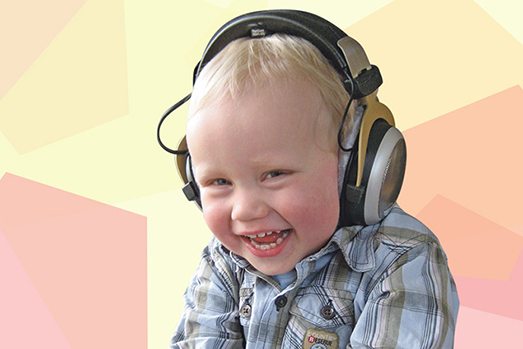![[Translate to English:] Grundlagen [Translate to English:] Grundlagen](/fileadmin/user_upload/TeaserBild/t_1_grundlagen.gif)
Areas of application
Systemic Listening Therapy can be applied to a wide spectrum of symptoms and disorders. A review of the medical history, a detailed discussion and a differential diagnosis will help determine whether listening therapy can provide the best form of treatment support to the child or adult. Other possible forms of treatment should also be considered during this discussion. In the case of children these could include: occupational therapy, speech therapy, learning therapy or even psychotherapy.
A: Possible areas of application for children
B: Areas of application for adults
C: Special areas of application in the field of education
Possible areas of application for children

A: Possible areas of application for children
The aim of listening therapy is to improve the combined function of hearing and the sense of equilibrium within the inner ear.
Listening therapy is principally recommended for:
A I: Problems or disorders of
- Auditory adaptability and sound (acoustic) preprocessing
- Central auditory processing and perception
- Postural control (equilibrium) and muscle tone regulation
A II: Symptoms and Diseases Illnesses
- Global speech, motor or psychological delays
- Language development disorders
- Developmental abnormalities associated with complicated pregnancies and deliveries or premature births.
- Learning difficulties, especially with respect to reading/writing
- Attention disorders
- ADD/ADHD
- Emotional abnormalities or disorders, such as shyness, anxiety, phobias, aggression.
- Pervasive developmental disorders, early infantile autism, atypical autism.
- Intellectual disabilities such as Down-Syndrome
- Brain damage, esp. post-partum with spastic paralysis.
- Behavioural problems associated with mental trauma
Symptoms for these disorders could manifest:
During infancy
- Shrill or weak crying
- Hypersensitivity to specific sounds
- Easily startled
- Little or no response to calls or noise
- Feeding problems
- Poor head control and delayed rolling from back to prone position
- …..
During Toddler Age
- Delayed language development
- Poor intelligibility (unclear articulation)
- Slurred “s” and “sch” sounds
- Delayed language comprehension
- Noise sensitivity
- …..
Kindergarten Age
- The child misunderstands questions and doesn’t follow prompts.
- Is easily distracted by sounds
- Although relatively calm and withdrawn at home, the child exhibits increasingly restless and aggressive behaviours, or is even more withdrawn.
- Is unable to identify sounds, gauge the distance and direction from which sounds are coming (maybe more prone to accidents)
- Sings off key and exhibits a poor sense of rhythm.
- Flat, monotone voice
- Muffled, inaccurate speech
- Interchanges similar letters
- Poor fine and gross motor skills; frequent falls
- Avoids balancing, swinging and rocking
- Exhibits difficulties in sequencing
- Exhibits poor sense of confidence
- …..
School Age
- Reading / writing difficulties
- Limited vocabulary
- Dysgrammatism
- Confuses letters
- Weak concentration (poor sustained attention/concentration)
- Easily distracted
- Tires easily
- Shows little enthusiasm
- Isolated, with few friends
- Poor posture
- Coordination problems
- Uncertain about right and left
- Child often appears disoriented, ex. messy, disorganized
- Doesn’t seem to understand much and has to be addressed multiple times
- Poor self-confidence
- Problems with grasping language flow, grammar, and/or foreign language vocabulary
- ….
Not all symptoms have to occur simultaneously! Establishing certain selection criteria can help determine whether listening therapy is preferred treatment method amongst the multitude of available treatment methods.
Areas of application for adults

B. Areas of application for adults
B. I: Specific hearing disorders
- Tinnitus
- Sudden Hearing Loss
- Ménières disease
- Certain forms of hearing loss
- ….
As with any of the aforementioned conditions, a preliminary examination by an ENT (Ear, Nose and Throat specialist) is mandatory. In these cases listening therapy is rarely curative, but can provide a significant relief of symptoms. In the case of tinnitus, symptoms may at first appear to worsen. This may be the result of more sensitized ability to hear.
B. II: psychological and psychosomatic areas application
- Burn out, midlife crisis
- Episodes of depression
- Anxiety, phobias
- As a supplement to a psychodynamic psychotherapy or psychoanalysis
- As a personal experience
- As part of a wellness program for the psyche: a recovery time, or taking time out for oneself.
- Sleep Disorders
- Functional spinal problems
- To regenerate and improve the quality of life with age
- …
B. III: Somatic (bodily) areas of applications
- Rehabilitation after a stroke
- Multiple sclerosis
- Voice disorders, dysphonia
- …
Patients with neurological disorders who undergo listening therapy experience a multitude of benefits. By primarily targeting lower frequencies they can experience an improved sense of balance, proprioception and muscle tone.
In stroke patients with hemiparesis, additional bone vibrators are attached to the paralyzed side of the body. Attaching them to the extremities, such as the wrist or leg improves sense of feeling and can improve motor coordination and reduce spasticity.
Listening therapy can also be effective against possible secondary conditions, such as in the case of depression in response to an illness.
B IV: For pregnant women who are preparing for birth
Listening therapy in the last month of pregnancy has been shown to reduce the birthing time as well as improve postnatal development in children at a hospital in Vesoul, France.
Special areas of application in the field of education

C: Special areas of application in the field of education
- Foreign language integration
- To improve voice and singing abilities
- To improve musical competence
- …
Listening Therapy has its roots in the treatment of voice and singing problems. The founder of listening therapy discovered that listening disorders were the cause of the voice problems that professional singers were experiencing. He developed the “electronic ear” in order to improve ability of singers to hear and listen.

